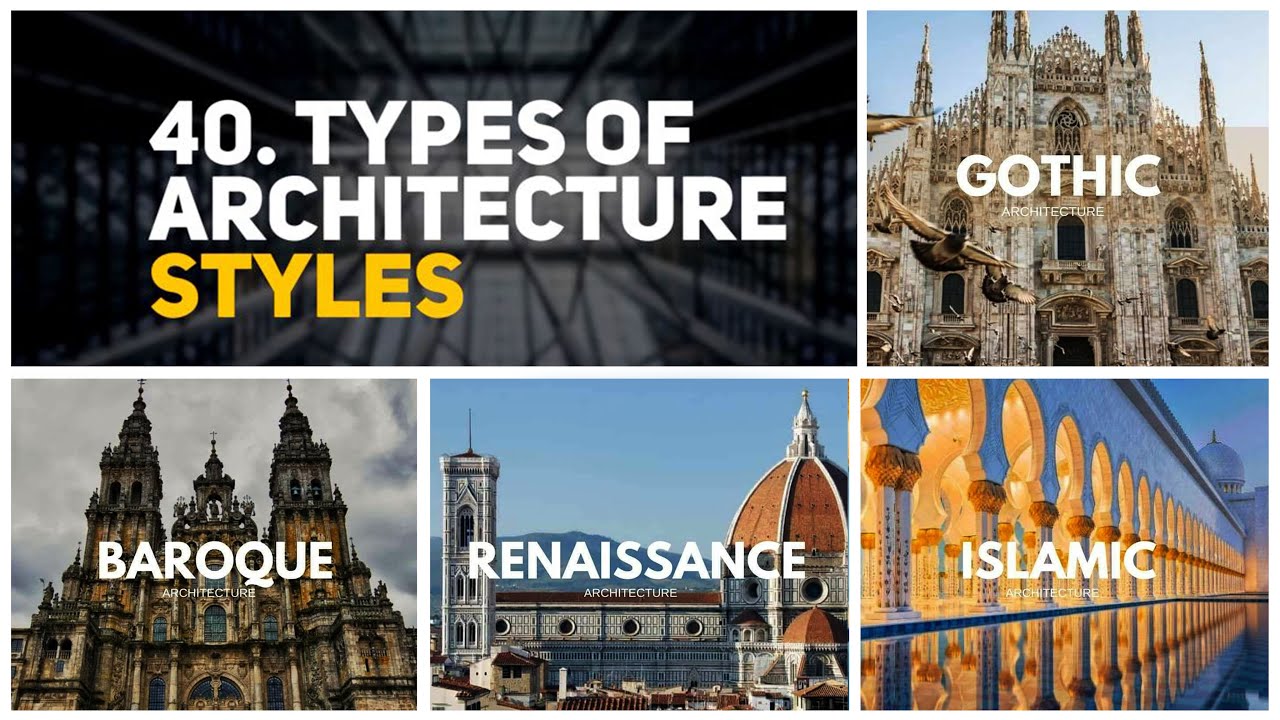Architecture Styles - From Classic To Contemporary
Architecture styles have played an essential role in shaping the built environment throughout history. From the classical beauty of ancient Greece and Rome to the bold and geometric shapes of Art Deco architecture, each style reflects the artistic, cultural, and social influences of its time.
Author:George EvansApr 19, 2023115 Shares1.9K Views

Architecture styleshave played an essential role in shaping the built environment throughout history.
From the classical beauty of ancient Greece and Rome to the bold and geometric shapes of Art Deco architecture, each style reflects the artistic, cultural, and social influences of its time.
Architects have used various styles and techniques to create buildings that are not only functional but also aesthetically pleasing, leaving a lasting impression on the world around us.
In this article, we will explore some of the most popular architecture styles throughout history, from classic to contemporary.
Popular Architecture Styles Of The 21st Century
Classical Architecture
Classical architecture refers to the ancient Greek and Roman styles of architecture that dominated the Western world for centuries.
The style is characterized by columns, pediments, and other ornate details that reflect the ideals of beauty, balance, and symmetry.
Gothic Architecture
Gothic architecture emerged in Europe during the Middle Ages and is characterized by its ornate and intricate designs, including pointed arches, ribbed vaults, and flying buttresses.
The style is often associated with medieval cathedrals and castles and is known for its use of natural light and soaring height.
Renaissance Architecture
The Renaissance was a period of great artistic and intellectual growth in Europe, and its influence can be seen in the architecture of the time.
Renaissance architecture is characterized by its use of symmetry, proportion, and harmony, as well as its focus on classical motifs, such as columns and domes.
Baroque Architecture
Baroque architecture emerged in the 17th century and is known for its ornate and dramatic style.
The style is characterized by its use of exaggerated details, such as curving forms, intricate sculptures, and elaborate ornamentation.
Art Deco Architecture
Art Deco architecture emerged in the early 20th century and is characterized by its bold, geometric shapes and use of industrial materials such as concrete, steel, and glass.
The style is often associated with the glamor and sophistication of the Jazz Age and is still popular today in many urban environments.
Contemporary Architecture
Contemporary architecture refers to the styles and trends in architecturethat are current and relevant today.
This includes a wide range of styles, from the sleek, minimalist designs of modern architectureto the more experimental and avant-garde styles of postmodern architecture.

40 Types of Architecture styles.
Innovative Materials And Techniques Used In Contemporary Architecture Styles
Contemporary architecture styles are constantly evolving, with architects incorporating new materials and techniques to create innovative and sustainable buildings.
Here are some of the most popular materials and techniques used in contemporary architecture:
1. Green Roofs
Green roofs are becoming increasingly popular in contemporary architecture, especially in urban areas where space is limited.
A green roof is essentially a roof that is covered in vegetation, providing insulation and reducing the heat island effect. Green roofs can also help to reduce stormwater runoff and improve air quality.
2. 3D Printing
3D printing technology has revolutionized the way architects design and construct buildings. With 3D printing, architects can create complex shapes and structures that would be impossible to build using traditional methods.
This technology is also more sustainable, as it reduces waste and allows for the use of recycled materials.
3. Cross-laminated Timber (CLT)
Cross-laminated timber (CLT) is a sustainable building material that is becoming increasingly popular in contemporary architecture.
CLT is made by gluing layers of wood together at right angles, creating a strong and durable material that can be used for walls, floors, and roofs.
CLT is also more environmentally friendly than concrete or steel, as it is a renewable resource that absorbs carbon dioxide from the atmosphere.
4. Prefabrication
Prefabrication is the process of constructing building components off-site and then assembling them on-site.
This technique can save time and money, as the components can be mass-produced in a factory and then transported to the construction site.
Prefabrication can also improve the quality of the building components, as they are manufactured in a controlled environment.
5. High-performance Glass
High-performance glass is a type of glass that is designed to reduce heat transfer and improve energy efficiency. This type of glass can help to reduce energy costs and improve the comfort of the building's occupants.
High-performance glass can also be used to create visually striking facades and windows, allowing architects to create buildings that are both functional and aesthetically pleasing.
Comparing Gothic And Renaissance Architecture Styles
When it comes to architecture, the Gothic and Renaissance styles are two of the most well-known and beloved styles in history.
While both of these styles emerged in Europe and share some similarities, they are also distinct in their own ways. Here are some key differences between Gothic and Renaissance architecture:
Gothic Architecture Style
- Gothic architecture emerged in the 12th century and lasted until the 16th century.
- Gothic architecture is characterized by its ornate and decorative style, with pointed arches, ribbed vaults, and elaborate tracery.
- Gothic buildings are typically tall and slender, with large stained glass windows and intricate stone carvings.
- Gothic architecture often includes flying buttresses, which help to support the weight of the building and distribute it more evenly.
- Gothic buildings are often associated with churches and cathedrals, but the style was also used for other types of buildings such as castles and universities.
Renaissance Architecture Style
- Renaissance architecture emerged in the 14th century and lasted until the 17th century.
- Renaissance architecture is characterized by its focus on symmetry, proportion, and harmony.
- Renaissance buildings are often inspired by classical Roman and Greek architecture, with round arches, domes, and columns.
- Renaissance architecture often includes decorative elements such as frescoes and sculptures, but they are typically more restrained and less ornate than in Gothic architecture.
- Renaissance buildings are often associated with palaces, government buildings, and public squares, but the style was also used for churches and other types of buildings.
People Also Ask
How Has Architecture Style Evolved Over Time?
Architecture style has evolved over time as a result of various cultural, social, and technological advancements.
From the early days of classical architecture to the modern styles of today, architects have been influenced by new materials, construction techniques, and design philosophies.
The evolution of architecture style has led to the creation of many distinct and unique styles that are representative of different time periods and cultural influences.
What Are Some Key Features Of Baroque Architecture Style?
Baroque architecture style is characterized by its grandeur, extravagance, and ornate decorations.
Some key features of this style include the use of dramatic and bold colors, intricate detailing, and the use of light and shadow to create depth and drama.
Baroque architecture is often associated with the Catholic Church and was used to convey the power and wealth of the church during the Counter-Reformation period.
How Has Technology Impacted Contemporary Architecture Styles?
Technology has had a significant impact on contemporary architecture styles, allowing architects to push the boundaries of design and create innovative and sustainable buildings.
The use of advanced 3D modeling software, virtual reality, and robotics has allowed architects to design and construct complex structures that were once thought impossible.
Additionally, advancements in materials science have allowed for the use of sustainable and environmentally friendly building materials, leading to the development of eco-friendly architecture styles.
What Are Some Popular Examples Of Art Deco Architecture Style?
Art Deco architecture style is known for its bold geometric shapes, sleek lines, and use of materials such as glass, steel, and concrete.
Some popular examples of this style include the Empire State Building in New York City, the Ocean Drive Historic District in Miami Beach, and the Hoover Dam in Arizona.
Art Deco architecture is often associated with the glamour and excess of the Roaring Twenties and is a popular style for hotels, cinemas, and other public buildings.
What Role Do Cultural Influences Play In The Development Of Architecture Styles?
Cultural influences have played a significant role in the development of architecture styles throughout history.
Each architecture style is a reflection of the cultural, social, and political influences of its time, and has been shaped by factors such as religion, art, and philosophy.
For example, Gothic architecture was heavily influenced by the religious beliefs of the time, while Renaissance architecture was influenced by the rediscovery of classical art and culture.
Cultural influences continue to play a role in the development of architecture styles today, with architects drawing inspiration from a wide range of cultural traditions and design philosophies.
Final Words
Architecture styles are a reflection of the artistic, cultural, and social influences of their respective times. Each style offers a unique glimpse into the history and evolution of architecture, showcasing the creativity and innovation of architects throughout history.
Whether you are a fan of the classic styles of the past or the contemporary designs of the present, architecture styles continue to inspire and shape the built environment around us.
As we continue to push the boundaries of design and incorporate new technologies and materials, we can look forward to seeing the development of new architecture styles that will shape the future.

George Evans
Author
George Anderson, an exceptional architectural designer, envisions and brings to life structures that transcend the realm of imagination. With an unwavering passion for design and an innate eye for detail, George seamlessly blends form and function, creating immersive spaces that inspire awe.
Driven by a deep appreciation for the interplay of space, light, and materials, George's innovative approach redefines the possibilities of architectural design. His visionary compositions leave an indelible mark, evoking a sense of wonder and transforming the built environment.
George Anderson's transformative designs and unwavering dedication continue to shape the architectural landscape, pushing the boundaries of what is possible and inspiring generations to come.
Latest Articles
Popular Articles